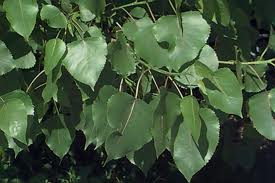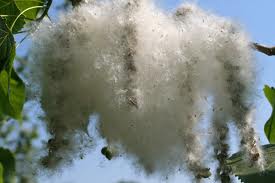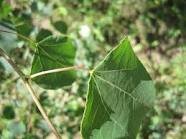Populus deltoides: Popular Poplars and Aspens
I know where there is one (1) Eastern Conttonwood. For a popular Poplar it is not common locally. Fortunately edible Poplars elsewhere are numerous and well-distributed. But why only one poplar nearby? The answer is roots.
The Eastern Cottonwood is an impressive tree and was once planted as a favorite street tree and shade tree. Their roots, however, had the habit of entering drain and sewer systems, clogging them. This led to many municipalities banning the Poplar. Not exactly environmental progress.
There are some three dozen species of Poplar in the world, about 15 in North America. In New England where I grew up Poplars were considered a “trash tree” short-lived and not used for much though there was one large Balm of Gilead my mother favored by the horse pasture. It was noticeably bigger than the other Poplars, and lived far longer. Even as a kid I marveled at how the leaves of the genus quaked in the wind. Old Timers — which meant adults — used to say when the Poplars showed their silver it was going to rain. These same adults also never said “Balm of Gilead” as three words but rather one: bah-mah-GILL-ee-id.
While Poplars and Aspens are in the same genus there are differences. Usually the winter buds of the Poplars are very resinous and have 12 to 60 stamens (the male part of the flowers.) The Aspens are only slightly resinous and have on 6 to 12 stamens.
Here in the south there are two Poplars and one Aspen, P. deltoides (the only local one) Populus heterophylla (found in northern Florida and the gulf states) and Populus grandidentata, found occasionally in North Carolina and Virginia.
The so-called inner bark, the cambium, of the poplars listed below is edible raw. It was eaten not only by North American natives but peoples in Europe and Asia. The cambium was often cut into strips and boiled or dried, ground and mixed with flour to make bread and or mush. It is high in Vitamin C. The sap can also be drunk and the catkins of some species are also edible.
Among the edible poplars are the Populus angustifolia (Narrow Leaf Poplar) Populus fremontii (Fremont cottonwood which actually might be a P. deltoides variation or even P. deltoides v. wislizeni or P. deltoides v. monilifera) P. grandidentata (Large Toothed Aspen) Populus sargentii (Sargent Cottonwood) Populus alba (White Popular from Europe) and Populus tremuloides, (the Aspen of Colorado fame.)
Medicinally the resinous, aromatic buds of the Populus balsamifera, Populus canadicans (aka giladensis) and Populus tremuloides are used as balsamic, expectorant and stimulant. The salve, used on burns and wounds is made by boiling the buds slowly in oil. The resin comes from a wax that coats the buds in the winter. The wax coats the buds to reduce water loss. So, if you want to make a salve you have to collect buds in the winter.
As for the name, Populus deltoides (POP-you-los del-TOY-deez). Populus is latin for “people” but can also mean a crowd or a multitude and in many places these trees grow in colonies. But scholars think it came from arbor-populi, meaning “tree of the people.” Deltoides means triangular, referring to the leaf shape.
Oh, the root wood of the Eastern Cottonwood was also used by the natives for drill and baseboard for friction fire lighting. Settlers used the logs to build stockades.
Green Deane’s “Itemized” Plant Profile
IDENTIFICATION: Eastern Cottonwood. Large tree to 100 feet, trunk 5 feet through. Bark silvery-white, smooth or lightly fissured when young, dark gray and deeply fissured on older trees. Twigs grayish-yellow, stout, with large triangular leaf scars. Twigs have a bitter, aspirin like taste. Winter buds slender, pointed, to .75 inch long, yellowish brown, resinous. Leaves are large, triangular, to 4 inches long and wide, flattened base, coarsely toothed, the teeth are curved and gland tipped, petiole is flat. Leaves are dark green in the summer, yellow in the fall.
TIME OF YEAR: Catkins on single-sex trees early spring. Male catkins, reddish-purple, to 4 inches long. Female catkins, green, 2.5 to 5 inches long, seed capsules in early summer, releasing numerous small seeds attached to cotton-like strands.
ENVIRONMENT: Likes to border streams and wet valley soil. In colonies of with willows, often first to inhabit new sandbars or bare flood plains.
METHOD OF PREPARATION: Inner bark edible raw or cooked. Roots dried for use in friction fire making. The wood is also used for boxes, crates, furniture, plywood, matches and paper products.




